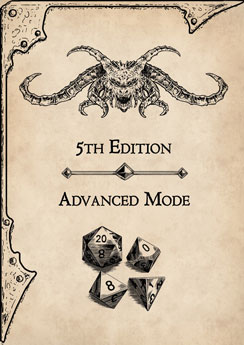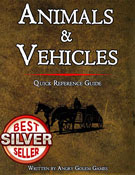Large monstrosity, unaligned
Armor Class 12
Hit Points 59 (7d10 + 21)
Speed 30 ft., fly 80 ft.
Proficiency Bonus +2
Proficiency Bonus +4 (5th Edition Advanced Mode)
| STR | DEX | CON | INT | WIS | CHA |
|---|---|---|---|---|---|
| 18 (+4) | 15 (+2) | 16 (+3) | 2 (-4) | 13 (+1) | 8 (-1) |
Saving Throws (suggested) Str +6, Con +5
Skills Perception +5
Senses darkvision 60 ft., passive perception 15
Languages —
Challenge 2 (450 XP)
Dive Attack (suggested). The griffon can perform a dive attack if it attacks from a height of 100 feet at least. While doing so, the griffon gains advantage with both claw attacks and inflicts double damage.
Grab on the Fly (suggested). If the griffon succeeds in at least one claw attack while performing the Dive Attack, then a target of Medium or smaller size is automatically grappled. The next round, the target may attempt to escape the grapple (escape DC 14) or can attack the griffon with disadvantage. The griffon can release the grapple at any moment and have the target suffers appropriate fall damage.
Keen Sight. The griffon has advantage on Wisdom (Perception) checks that rely on sight.
Rear Claws (suggested). If both claws hits, the griffon may rake with both its rear claws dealing 11 (2d6+4) slashing damage each as a bonus action. No hit roll required.
ACTIONS
- Multiattack. The griffon makes three attacks: one with its beak and two with its claws.
- Beak. Melee Weapon Attack: +6 to hit, reach 5 ft., one target. Hit: 13 (2d8 + 4) piercing damage.
- Claw. Melee Weapon Attack: +6 to hit, reach 5 ft., one target. Hit: 7 (1d6 + 4) slashing damage.
5th Edition Advanced Mode
Limiting the power of a character and making the overall difficulty of the game harder, does not reduce the creativity, indeed it does quite the opposite.
The Game Master has the option to use any and all of the instances proposed in this guide, or just some of them according to their preference.
It is the lack of something that move and motivate characters, not the abundance of it
DESCRIPTION
A griffon is a majestic creature that combines the features of a lion and an eagle. It has the body, tail, and hind legs of a lion, and the head, wings, and forelegs of an eagle. Its fur and feathers are usually brown or golden, but some griffons have other colors, such as black, white, or gray. A griffon is about 8 feet long from the tip of its beak to the end of its tail, and has a wingspan of 25 feet or more. It weighs about 500 pounds.
COMBAT
Griffons are fierce predators that hunt for large prey, such as deer, horses, or even humans. They use their keen sight and sense of smell to spot potential targets from high above, and then swoop down with great speed and force. They attack with their powerful beak and claws, tearing flesh and bones with ease. Griffons are also very agile in the air, able to dodge and maneuver around obstacles and enemies. They are not afraid to fight other flying creatures, such as dragons or wyverns, and will defend their territory fiercely.
Griffons hunt in prides, searching the plains and forests near (within 20 miles) their lair for horses and herd animals. If the prey is horse or horse-kin, griffons are very likely to attack even if the horses have riders. Griffons hunt only for food, so a rider who releases one or two horses can usually escape unharmed (though in all likelihood his horse won’t). Any attempt to protect a horse brings the full fury of the attacking griffons on the protector.
When attacking ground targets, griffons use their great size and weight to swoop down from above and raking their opponent with the talons before landing nearby. Griffons always fight to the death if there is horseflesh at stake.
In aerial combat, griffons are equally fierce, lunging into battle and tearing at their opponent until they or their prey are dead. Many a griffon has plummeted to its death with a struggling hippogriff caught firmly in its grasp.
HABITAT / SOCIETY
Griffons prefer to live in mountainous regions, where they can find caves or ledges to nest and roost. They are usually solitary or live in mated pairs, but sometimes form small flocks of up to six members. Griffons are very territorial and will attack any intruders that come near their nests or hunting grounds. They are also very loyal to their mates and offspring, and will fight to the death to protect them.
Griffons are not very intelligent, but they have a sense of pride and honor. They respect strength and courage, and will sometimes bond with creatures that prove themselves worthy. Some griffons have been tamed by humans or other races, and serve as loyal mounts or companions. However, taming a griffon is not an easy task, as it requires a lot of patience, skill, and animal handling. A griffon will only accept a rider that it trusts and respects, and will not tolerate any mistreatment or abuse.
Griffons prefer rocky habitats, near open plains. Once griffons establish their territory, they remain until the food supply has been exhausted. Griffons, like lions, live in prides, with each pride comprising several mated pairs, their young, and one dominant male.
The dominant male is responsible for settling territorial disputes with other prides and choosing the direction the hunt will take. Each pair of mated griffons in the pride has its own nest, located near the pride’s other lairs. Griffon nests are usually situated in shallow caves, high along a cliff face.
The nests are made of sticks and leaves, as well as an occasional bone. Griffons collect no treasure, but their caves frequently contain the remains of unfortunate travelers who tried to protect their horses from the griffons. During spring, female griffons lay one or two eggs that hatch in the late summer.
For the first three months griffon young are known as hatchlings; thereafter, until they mature the young are called fledglings. Griffon young grow rapidly for three years until they are large enough to hunt with the pride. Adult griffons are extremely protective of their young and attack without mercy any creature that approaches within 100 feet of the nest.
ECOLOGY
Griffons are carnivorous creatures that need a lot of food to sustain their large bodies and high metabolism. They hunt for prey every day, sometimes traveling long distances to find suitable targets. They prefer fresh meat, but will scavenge on carcasses if necessary. They also drink a lot of water, especially after a meal.
Griffons have a lifespan of about 60 years. They reach maturity at the age of 5, and can mate at any time of the year. A female griffon lays one or two eggs at a time, which hatch after three months. The young griffons are born with fur and feathers, but cannot fly until they are one year old. They stay with their parents until they are three years old, and then leave to find their own territory.
Griffons have few natural enemies, as they are formidable fighters and can escape most threats by flying away. However, they sometimes clash with other predators, such as dragons, wyverns, manticores, or rocs. They also face dangers from poachers or hunters who seek their fur, feathers, claws, or beaks for trophies or magical purposes. Griffons are considered a rare and majestic sight by most people, and are revered by some cultures as symbols of nobility and courage.
If trained from a very early age (three years or less), griffons will serve as mounts. The training, however, is both time-consuming and expensive, requiring the expertise of an animal trainer for two years.
Once trained, though, griffons make fierce and loyal steeds, bonding with one master for life, and protecting him even unto death. A griffon mount knows no fear in battle, but attacks any horse or horse-kin in preference to other opponents.
Acquiring a griffon fledgling is a very dangerous venture as the adults never stray far from the nest and fight to the death to defend eggs or young. Any given griffon nest is 75% likely to contain one or two fledglings or eggs. Fledgling griffons sell for 5,000 gold pieces on the open market; eggs sell for 2,000 gold pieces each.
Griffon is employed as component to empower the following spells:
Griffons can be used as mounts or pulling animals for vehicles.
The statistics are detailed in the D&D 5e Animals & Vehicles reference guide. Just have a look at the preview on DrivethruRpg.

